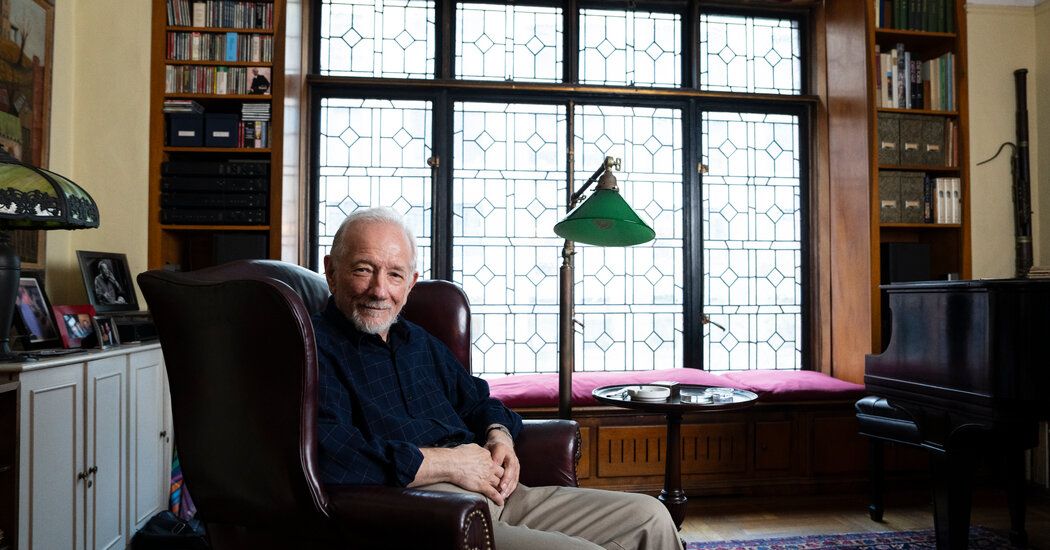To understand the Broadway orchestrator's role, look up composer Stephen Sondheim's piano demo for the song “Losing My Mind” from the musical “Follies” and then compare it to the version on the original cast recording. The tone of the demo is melancholic and resigned, with a hint of whiskey bar. In the finished version, the song sounds transformed: rising notes in the strings, brass interjections, and crashing cymbals create a powerful climax, evoking the pain and inner turmoil contained in the lyrics.
What happened? The short answer: Jonathan Tunick.
“I seem to have a nose for the theater, and I really do,” Tunick, the prolific Broadway orchestrator, said during an interview in his book-lined studio on the Upper West Side. “If something works, you can almost smell it.”
In fact, Tunick, 85, has orchestrated nearly all of Sondheim's musicals since 1970, including “Company,” “A Little Night Music,” “Pacific Overtures,” “Into the Woods” and “Passion.” For other composers, he orchestrated “A Chorus Line,” “Nine,” “The Color Purple,” and “A Gentleman's Guide to Love and Murder.” Winner of the EGOT (that rare Emmy, Grammy, Oscar and Tony winner), Tunick won a Tony for his orchestrations of “Titanic” in 1997 (the first year the award was given) and an Academy Award for the film version of “A Little Night Music.” Last fall he became the first orchestrator to hang his portrait in Sardi's.
At Sardi's event, at least a couple of guests were heard wondering aloud: What does a Broadway orchestrator really do?
Typically, for a Broadway show of the type Tunick might orchestrate, the composer provides the vocal part along with some type of accompaniment. That accompaniment can be a basic chord score, a fully realized piano part, or anything in between. It's the orchestrator's job (a long and lonely job, Tunick said) to turn that accompaniment into something an orchestra can play.
Of course, there are more poetic descriptions. In Steven Suskin’s book “The Sound of Broadway Music,” the original “Carousel” orchestrator, Don Walker, compared orchestration to “the clothing of a musical thought”; Hans Spialek, who orchestrated “On Your Toes” and many other Rodgers and Hart shows, compared it to “painting a musical picture.”
Tunick's favorite analogy is “enlightenment for the ears.” He often consults with a show's lighting designer to determine what colors and hues will be used on stage. The orchestra, he said, has the ability to “provide its own nuances of light, darkness, warmth and texture to the music and lyrics.”
For the Broadway premiere of “Company” in 1970, Tunick created a crisp, bright sound that was the aural equivalent of Boris Aronson's chrome-and-glass set. Tunick conjured a hellish soundscape for the macabre “Sweeney Todd”: churning strings, flaming horns and frenetic xylophones that evoke the scurrying of rats. For “Merrily We Roll Along,” he replicated the bold, bold sound of 1960s Broadway overtures.
Tunick makes sure the instruments never get in the way of the words. “He's always aware of the lyrics and the dramatic moment,” said Joel Fram, musical director of the Broadway revival of “Merrily We Roll Along.” He pointed to that show's “Our Time” as an example, with its twinkling piano, simple woodwind solos, gentle rhythmic figure on bassoon and pizzicato cello, a fitting soundtrack for the youthful optimism of the show's protagonists at the time. . “He serves the song instead of overwhelming it.”
Charlie Alterman noted his favorite orchestration on “Company,” for which he was musical director for the recent national tour. “It's a bubbling of emotion somewhere within Bobby's character,” he said, referring to the moment in the final number, “Being Alive,” when, unexpectedly, the melody of “Someone Is Waiting,” an earlier song filled with a longing for companionship sneaks in like a budding understanding.
“Deep down there is something that reminds us of the feeling of 'Someone is waiting' and wants to be heard,” Alterman said. The choice is intriguing on an intellectual level, “but on a visceral level, it does that amazing thing that good music does, where you can't explain it in your mind, but it's clear as day in your heart.”
Tunick remembers introducing those few notes into “Being Alive” and that Sondheim was pleased with the addition. “At least that showed him that he was paying attention,” Tunick said.
More than just making music sound pretty or pleasant, a great orchestrator “is also a playwright, telling the story and reflecting character in the orchestral sound,” said Michael Starobin, who orchestrated “Sunday in the Park With George” and “Assassins” by Sondheim. “
As the “Being Alive” example above demonstrates, orchestration “can hint at unspoken secrets,” Tunick said. “Things that the characters don't say, or don't want to say, or don't even know.”
A PIECE OF MUSIC It made a big impression on young Jonathan Tunick: “Tubby the Tuba,” the 1945 children's song, centers on a forlorn tuba who longs to play the melody instead of just the bass line. Like “Peter and the Wolf,” the song highlighted the distinct characters of the orchestra's individual instruments. “This idea penetrated my growing brain,” he said. “It became a lifelong obsession.”
Tunick received some cursory piano lessons when he was young growing up in New York (“I read the Diller-Quaile book in a week”), but it was a clarinet, a gift from his amateur clarinetist uncle, that kept his interest.
While a student at what is now Fiorello H. LaGuardia High School for Music, Art and Performing Arts, he founded his own band and played in the school's orchestra as well as the All City High School Orchestra. He began writing music, majoring in composition at Bard College, before paying his way to Juilliard by performing with the school's orchestra.
I was much more interested in what was happening in Birdland than on Broadway. “Musicals at that time were kind of boring,” he said. “It was disposable popular entertainment. You would throw it away like a used tissue. I was a little more fashionable than that.”
While in college, a girlfriend introduced him to Frank Sinatra and the possibilities of orchestral arrangements. She was struck by the way Nelson Riddle's arrangements on Sinatra's breakout album, “In the Wee Small Hours,” provided commentary, color and context. “I was painting shades,” Tunick said.
College was followed by 10 years of intermittent work as an arranger and orchestrator before a big break: orchestrating “Promises, Promises,” whose jazz-influenced score by Burt Bacharach brought a refreshingly contemporary sound to Broadway.
Emboldened by the success of that show, Tunick called Sondheim, whose originality and ingenuity as a songwriter he had admired since hearing “A Funny Thing Happened on the Way to the Forum.” Tunick offered Sondheim his services for his next project.
When he first heard the piano performances of the songs that would become “Company,” Tunick was taken aback. With a few exceptions – “Barcelona” sounds like Erik Satie via Brazil, he observed – the score had a sound entirely its own. “If anything, it was kind of like Stravinsky, but not quite,” Tunick said, citing the quirky melodies and rhythm of “The Little Things You Do Together” as an example of Sondheim's striking originality. “That is that? In all cases I had to think carefully.”
At first, Tunick wasn't overly confident in his ability to do the material justice. “He was terrified,” he said. But, starting with “Company,” Tunick helped define Sondheim's signature sound. In contrast to the sumptuous roar of an entire orchestra at full blast, this was a sound defined by sharper lines, purer colors, more instrumental solos, more variation and contrast of tonal effects.
That sound is certainly present in “Here We Are,” the new musical about privileged urbanites trapped in an existential nightmare. As befits the sinister surrealism of the source material (Luis Buñuel's films “The Discreet Charm of the Bourgeoisie” and “The Exterminating Angel”), Tunick's underscoring at times resembles the effervescently eerie music of a Looney Tunes cartoon. And, once again, the orchestra knows something that the characters don't, greeting with the happy exclamation “What a perfect day!” with notes that shake and hit.
Orchestrating that show after Sondheim's death in 2021 was “like going through the letters of a deceased friend,” Tunick said, “editing them for publication.” Tunick was happy with the result. “We went out on a high note,” he added.
However, the musical collaboration will continue.
Having re-orchestrated several Sondheim shows, not just those he originally orchestrated, Tunick is adapting the score of “A Little Night Music” for full orchestra, making it more suitable for performance in symphony orchestras and opera houses. This year he will conduct a concert and record the new version.
Of course, in an even deeper and lasting way, through successive cast albums and productions, the Sondheim-Tunick collaboration will continue to inspire generations of musical theater lovers and reward ever closer listening.
Tunick's last meeting with Sondheim turned out to be just a few weeks before the composer's death, at a concert of Tunick's work at the Sharon Playhouse in Connecticut. Tunick took the opportunity to address a few words to his longtime collaborator: “I know you hate sentimentality. But I have to tell you how much it means to me to work with you all these years.”
As Tunick tearfully reminisced, Sondheim put his arm around him and said, “Jonathan, we're lucky to have met.”












